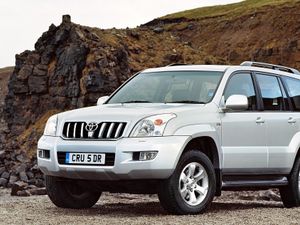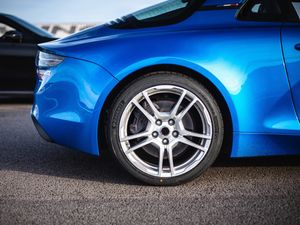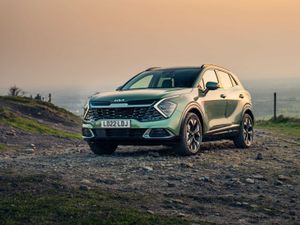Off-roading in a Land Rover for the first time: What is it like?
Last week saw me jump behind the wheel of two mud-plugging SUVs, the Range Rover Sport and Land Rover Defender.
Up until last week, I had never been off-roading before. But, Land Rover UK invited me up to its Eastnor driving experience centre to test out some of the go-anywhere technology fitted to its vehicles to see just what it’s like to tackle difficult conditions in a four-wheel-drive.
When you’re offered to go mud-plugging in some of the world’s most capable off-road vehicles you never turn the opportunity down, and for me, it would be a first-time experience too.
Land Rover was showing off its latest collection of driving modes when it comes to the wet, rough and wild stuff. This included Wade control and Adaptive Off-Road Cruise Control or AOCC.
For the first stint, I got behind the wheel of a Range Rover Sport P510e First Edition. I would be driving through the rutted and narrow forest route first. It consisted of steep grass slopes, bumpy terrains and muddy tracks. As we entered the wilderness, I was a little nervous as it was all new territory for me.
As I drove onto the gravel track with a steep incline, the Sport was in its gravel terrain response setting. The system maximises the traction control, increases the suspension to improve ground clearance and improves the throttle response. The car performed faultlessly as though it was born to do this type of driving with everything feeling very composed, quiet and effortlessly achieved.

My instructor, Clarky, was sitting in the front passenger seat and was there to give us a guide on how the latest technology worked. The first of the new additions was the car’s rear-wheel steering, which essentially means the rear wheels turn in the opposite direction to the front ones enabling a turning circle of 11 metres – the same as the Volkswagen Golf. This improves manoeuvrability for on and off-road use and takes the strain out of any awkward encounters a big vehicle such as a Range Rover may find.

As I drove onto the grass hills and fields, it was the perfect opportunity to see how the AOCC worked. Adaptive Off-Road Cruise Control is engaged via the steering wheel controls. The system senses ground conditions and automatically fine-tunes the speed of the vehicle to maintain stability, control and comfort – depending on which of the comfort levels has been selected. It uses multiple algorithms to sense and detect the terrain and vehicle movements such as body tilt, roll and pitch. The comfort levels are selected by using the same buttons on the steering wheel that operate the Adaptive Cruise Control. Once you’ve selected the speed of the vehicle and comfort level, the driver can focus on steering the vehicle, with the cruise control consistently monitoring the terrain and gradients.
If the vehicle is put into its highest comfort mode, the car will go slower to maintain a smooth and composed off-road experience. However, lower the comfort and the system will increase the speed closer to the set preference the driver has made on the AOCC.

I then jumped into a Land Rover Defender with another instructor, Meg. We drove over to the other side of the course for some wading in water. This was to test the firm’s latest Wade mode and sensing technology that was first introduced in 2020. I started off driving through a river that turned out to be a fairly deep stream, but thanks to air suspension fitted to my particular Defender – enabling a maximum wading depth of up to 900mm – this didn’t prove an issue in the slightest.
How the system works is by softening the throttle response and setting the heating and ventilation to recirculate air. It also turns off the start-stop function, locks the driveline and adjusts the ride height. The Wade sensing can be activated and deactivated using terrain response. The exterior heating vents are closed off to prevent water ingress and our car fitted with air suspension automatically lifts the ride height to its off-road setting.
As I drive into the water, I can hear a slight trickling surrounding the car making me even more cautious and slowing my speed down. As I gingerly manoeuvre the Defender around the tight river, there were moments where I thought the water was going to make its way into the cabin, but the car behaved brilliantly and with the technology you also get a warning chime a bit like a parking sensor to tell you when the wading depth is getting too high – which is good to know from my point of view.
After I de-select the system it gently applies and wipes the brakes to make sure the stopping power is still at its best for the next application.
Both cars I drove were plug-in hybrids that have battery packs on board, however, what I wanted to know is if there were any additional changes between Land Rover’s of yesteryear and the modern counterparts of today with the firm’s latest off-road technology.
The PA news agency spoke to Mike Smith, project manager for JLR off-road development and he said: “Predominantly the technology across the two is the same. The advantage you have with a PHEV is you have the option of going with the machine only, so you can drive just on the electric motor that’s in the transmission. What that ultimately gives is when we think about Range Rover as it stands at the moment, the vast majority can be done with the engine off – which is a really nice thing to do as it’s really quiet and relaxing.”
Additionally, he spoke about the development of these new technologies and what goes into them to make the Land Rover brand top of the class when it comes to off-roading, he said: “There is a huge amount of people at JLR who will be involved in how all the technology comes together. We would start off with the concept, then look at the enhancement we would like to offer the customer and then that has to go through a proof of concept. Is it feasible? What does it offer the customer and what is the benefit?”
He added: “Once all that’s done we then have to look at how do we get that into a car? What technology do we need, what sensors and what feedback from the car to be able to make it effective? And then we start talking about the product of where it is going to work, but in that process, there could be anything from 10 to 100 people all having to play a part on where the technology needs to be.”
Overall, my first time driving on the rough stuff has been an enjoyable and memorable experience. The engineers at Land Rover really know how to develop a car that can cope with any abuse that is thrown at it, and with its latest AOCC and Wade Technology, I’m looking forward to the future of what the brand has to offer next.





